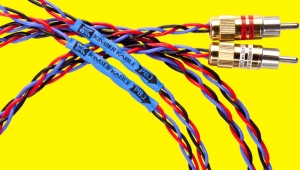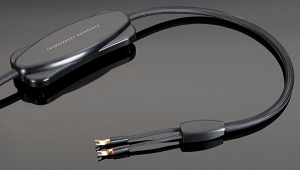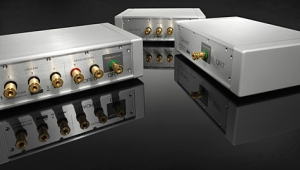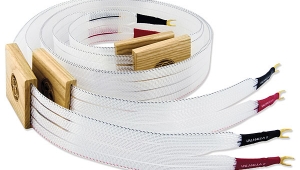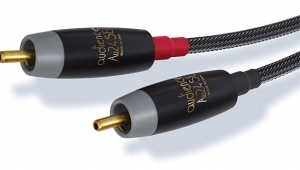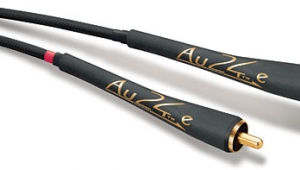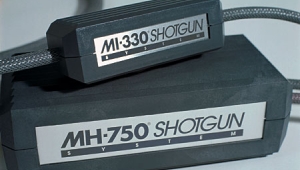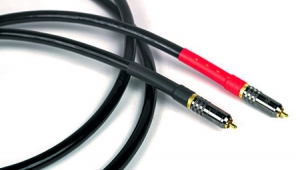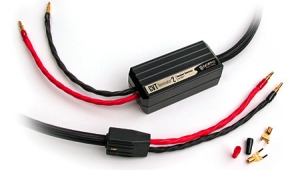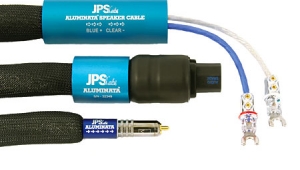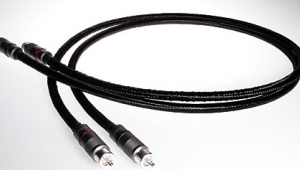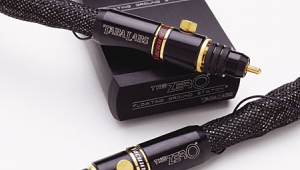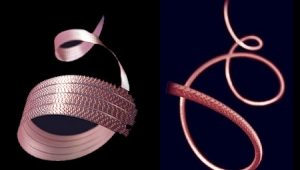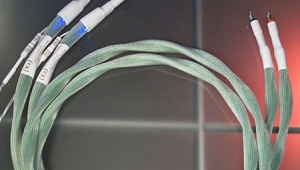| Columns Retired Columns & Blogs |
Alpha-Core Micro-Purl & TQ2 interconnect, Python MI2 speaker cable Page 2
The Alpha-Cores were also very good in terms of their reproduction of dynamics, again, particularly at the louder end of the scale, from f to ffff. Orchestral crescendos were reproduced without strain or confusion, and sharp impacts—rimshots, for example—were precise and explosive.
Where the Alpha-Cores fell a bit short of the super-premium cables was at the smaller, subtler end of the scale. Very-low-level detail, like the tonal shadings and textures that clearly identify individual instruments within a section, weren't as clear as with my reference wires. For example, the Alpha-Cores made it difficult to imagine what brand of guitar Dwight Yoakam plays on his killer acoustic album, dwightyoakamacoustic.net (Reprise 47714-2). Yoakam's guitar and voice were vivid and clean, but is the guitar a Gibson, a Martin, a Guild...or something else entirely?
The Alpha-Cores' handling of space, too, was a mixed bag. Images were vivid, solid, and precisely located, and the soundstage was wide and deep. On the minus side, however, the images seemed to run together slightly rather than be specifically bounded and separated by a distinct cushion of air. There was a decent sense of the hall and its boundaries, but the ambient environment—the surrounding air—just didn't penetrate down into the spaces that should have been between the instruments. This was perhaps most evident in the depth dimension; while the soundstage as a whole was reasonably deep, the individual images lacked dimensionality.
That cymbal in Ernestine Anderson's "What a Diff'rence a Day Makes" was a good example. The instrument itself was nicely reproduced, but there wasn't a tangible cushion of air around it, or the gentle melting of the expanding, shimmering overtones into the surrounding space. Instead, the shimmer was truncated abruptly at the image's edges.
One area where the Alpha-Cores were a definite winner, however, was in their immunity to noise. My house sits just below a forest of radio towers, and I've found that only exceptionally well-shielded single-ended cable designs work in my system. The Alpha-Cores were absolutely, positively, quiet—period.
And these wires were an absolute joy to work with: wonderfully flexible, and solidly terminated with a quality of connectors that shames many more expensive cables. Bravo!
Theme and Variations
Although the various Alpha-Core models mostly shared the characteristics I've described above, there were significant differences between them. To triangulate on each of the cables' individual characteristics, I played mix'n'match with several of my reference cables, swapping in the Alpha-Cores one at a time.
The basic Micro-Purl Cu displayed all of the attributes mentioned in the previous section, but its presentation was very musical overall. The lacks of inner detail, edge definition, and depth were apparent, particularly on vocals, but seemed to intrude very little on the music. "Tanquerey" was a good example. When I substituted the Micro-Purls for my reference cables, both Johnnie Johnson's lead and the background chorus sounded a bit pale and two-dimensional—but the effect quickly faded into the music, leaving a very satisfying presentation. The slight prominence of the bass line was most notable with the Micro-Purl Cus, as was the extra projection and slight forward placement of the piano. The Micro-Purl Cu had the warmest tonal perspective of all the interconnects, and the one that I found most natural. It also seemed a bit more coherent, with a more expansive soundstage—particularly in terms of depth and dimensionality—than its silver-conductor brother. Bottom line? The Micro-Purl Cu is a great budget cable and, at $78/m, a great value.
The $127/m Micro-Purl Ag interconnects were, to my ears, the least successful of the bunch. They lacked the Cu version's slight bass prominence and forward perspective, but from there on, it was no contest. The Ag's soundstage was noticeably more two-dimensional, and even within that plane, individual instruments were more congested and run together. Nor was it as dynamic as the copper version, sounding a bit washed out and constricted in comparison. Macro- to mezzo-level detail was more prominent with the silver version, but not so the finer, small-scale stuff.
On "Tanquerey," about two-thirds of the way through Keith Richards' solo, it sounds as if a bottle cap falls to the floor and bounces. With the Ags, that sound was prominent, but the subtle cues that make it seem real weren't as well reproduced as with the garden-variety copper version. Finally, the Micro-Purl Ags had the leanest, lightest tonal balance of the bunch, making pianos sound a bit tinny and robbing instruments and voices of some of their weight and body. Stick with the $78 version and spend the rest on a decent bottle of cabernet.
The TQ2 interconnect is the most expensive of the Alpha-Cores, at $186/m pair ($687 for my 6m run). But not only was it the best of the bunch and a great-sounding budget cable, the TQ2 was a great-sounding cable, period. It's a silver-conductor model, but sounded a lot more like a super version of the Micro-Purl Cu than the Ag. When compared with my reference Nirvana or Synergistic wires there was a bit of the forward perspective and slight bass prominence, as well as a slight lack of depth and dimensionality, but the shortcomings were slight, and obvious only in direct comparisons. Taken on its own, the TQ2 had an expansive soundstage, decent dimensionality, and even a reasonable—if not equal to the very best—sense of air between the individual images.
The TQ2's tonal balance more nearly approximated the Micro-Purl Cu's as well: still slightly to the cool side of neutral, but just barely. Both the top and bottom ends were strong, quick, and articulate, and the midrange had a lot of the inner detail and textural nuance that the Micro-Purls lacked. Still not quite up to the standards of the Nirvanas, but really quite good.
As I write this, I'm listening to the JVC XRCD of Duke Ellington's Duke's Big 4 (JVCXR-0022-2), and it points out all of this. There's a tight, strong, warmly rounded bottom end, and Louis Bellson's cymbal is crisp and shimmery, with a decent sense of the air around it. Through the midrange, Joe Pass's guitar is richly textured and dimensional, and Ellington's piano notes are just right, with a sharp hammer strike and a nice bloom as the string and soundboard resonances blend and expand.
At $195/1m pair, the TQ2 moves toward the "midprice" range—too expensive for a $1000 or $1500 system, but a good candidate for inclusion in a simple $5000 system. I strongly recommend giving them a listen, even in a much more expensive system, before you drop thousands on super-premium cables. The TQ2 is a very impressive interconnect, and there may well be a better place to invest the dollars saved.
Of all the Alpha-Cores, the Python MI2 speaker cables sounded the most like a budget cable; in other words, their shortcomings were immediately obvious. Unlike the interconnects, the MI2's tonal balance was somewhat to the warm, dark side of neutral. Their bottom end was full and powerful, but lacked a bit of dynamic snap and precision. On top, there was a noticeable lack of air and extension. Cymbals, for example, were down a bit in level, and the initial impact and ring were emphasized over the floating, shimmering decay. The midrange lacked dimensionality and inner detail, which, combined with a slight rounding of dynamic transients, gave the Pythons a laid-back, somewhat dulled sound. The Pythons weren't amusical or jarring, just not as engaging as the best cables—or the Alpha-Core interconnects. Their soundstage was also foreshortened in depth, and ambience cues weren't as apparent or as well-integrated as I've heard with other cables.
The bottom line: The Python is a good budget cable but no giant-killer. Its shortcomings were subtractive, hence not jarring, but they did deplete the music of a bit of its sparkle and life. I certainly recommend that they be considered for inclusion in a low- to midpriced system, but I also suggest auditioning competing models from companies like Kimber, Nordost, and Straight Wire, to see which set of compromises best fits your system and listening preferences. But as your overall system cost escalates, I believe you'd be better off exploring more expensive options.
Summing Up
The Alpha-Core Micro-Purl, TQ2, and Python MI2 nicely address the need for high-quality, reasonably priced cables. Well-designed and -constructed, they're good, solid performers that succeed particularly well in areas that will be synergistic with lower-priced electronics and speaker systems. They're tonally neutral—or just slightly cool—and do a great job on mid- to large-scale dynamics and detail, as well as producing vivid, solid images that are firmly located on the soundstage. Their failings, compared to the very best cables I've heard, are in dealing with a level of subtlety that's likely not a huge consideration with the gear they're priced to match. Even in a topflight, high-resolution system, their shortcomings are largely subtractive and relatively easy to listen around. It was only when I replaced the Alpha-Cores with my reference Nirvana wires that I really had to confront and acknowledge their shortcomings.
Conclusions
The Alpha-Core Micro-Purl Cu and Python MI2 cables join a select group of exceptional-value cables that includes wires like Belden's Platinum Synapse interconnects, Kimber's PBJ interconnect and 8TC speaker cables, and Nordost's Blue Heaven. Price-wise, they fall somewhere near the middle of this group, and the same can be said for their performance. I unhesitatingly recommend their inclusion in any budget system, and strongly suggest that anyone cabling even an upscale system give them a serious audition. The TQ2 interconnects are a step beyond "good for the money" and well into the realm of "good at any price." Coupled with their still very modest cost, their performance represents a true bargain—one of those undiscovered gems.
Finally, I urge more than a few cable manufacturers to give these wires a look and a listen—their performance, ease of use, and build quality are well above the industry norm.
- Log in or register to post comments
